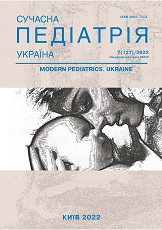Clinical and paraclinical manifestation COVID-19 in different age children
DOI:
https://doi.org/10.15574/SP.2022.127.15Keywords:
children, COVID-19, SARS-CoV-2Abstract
COVID-19 is an infectious disease caused by a new coronavirus first discovered in 2019. The infection has spread rapidly throughout the world and affects people of all ages. Thus, 12.7% of all SARS-CoV-2 patients are children.
Purpose - to establish the clinical and paraclinical manifestations of the course of COVID-19 in children, depending on age to predict the severity of the disease’s manifestation.
Materials and methods. The 60 children aged from 3 months to 17 years old with laboratory-confirmed SARS-CoV-2 were examined. All patients underwent general clinical, laboratory, and instrumental examinations and received therapy according to Ukrainian National protocol. SARS-CoV-2 infection was confirmed by real-time PCR.
Results. Thus, in young children COVID-19 begins acutely (90.0%) with intoxication (75.0%), fever (65.0%), nasal congestion (25.0%), rhinorrhea (20.0%), dry cough (60.0%), increased ESR and C-reactive protein (55.0%). The course of COVID-19 in children 4-6 years is accompanied by acute onset (85.71%), fever (85.71%), pharyngitis (85.71%), lymphopenia (28.56%), and no CT signs of lesions (71.43%). In children 7-12 years old, COVID-19 causes intoxication (88.89%), fever (83.33%), pharyngitis (55.56%), dry cough (77.78%), lymphocytosis (16.67%) with accelerated ESR (38.89%) and pneumonia (38.89%). The course of COVID-19 in children was older than 13 years old characterized by fever (73.33%), pharyngitis (66.67%), dry cough (73.33%), olfactory loss (20.0%), leukopenia (20.0%), ESR acceleration (20.0%), and a decrease in prothrombin (13.33%) without pulmonary lesions (73.33%).
Conclusions. These data suggest that the severity and duration of clinical and laboratory manifestations of COVID-19 depend on the child’s age. The course of COVID-19 in children of all age groups is mostly of moderate severity with a favorable prognosis ((56.67%) hospitalized children did not have any complications). Only children from 7 to 12 years old need additional attention due to the severe manifestations of intoxication (88.89%) and the risk of complications with pneumonia (38.89%).
The research was carried out in accordance with the principles of the Helsinki Declaration. The study protocol was approved by the Local Ethics Committee of the participating institution. The informed consent of the patient was obtained for conducting the studies.
No conflict of interests was declared by the authors.
References
AAP. (2021). Children and COVID-19: State-Level Data Report. American Academy of Pediatrics. URL: https://services.aap.org/en/pages/2019-novel-coronavirus-covid-19-infections/children-and-covid-19-state-level-data-report/.
Dong Y, Mo X, Hu Y et al. (2020). Epidemiology of COVID-19 Among Children in China. Pediatrics. 145 (6): e20200702. https://doi.org/10.1542/peds.2020-0702; PMid:32179660
Guan W‐J, Ni Z‐Y, Hu YU et al. (2020). Clinical characteristics of coronavirus disease 2019 in China. N Engl J Med. 58 (4): 711-712. https://doi.org/10.1016/j.jemermed.2020.04.004; PMCid:PMC7266766
Huang C, Wang Y, Li X et al. (2020). Clinical features of patients infected with 2019 novel coronavirus in Wuhan, China. Lancet. 395 (10223): 497-506. https://doi.org/10.1016/S0140-6736(20)30183-5; PMid:31986264
Kramaryov SO, Seryakova IYu, Yevtushenko VV, Kaminska TM. (2022). Comparative characteristics of the third wave of coronavirus disease in children with previous outbreaks. Modern Pediatrics. Ukraine. 4 (124): 5-14. https://doi.org/10.15574/SP.2022.124.5
Li Q, Guan X, Wu P Wang et al. (2020). Early Transmission Dynamics in Wuhan, China, of Novel Coronavirus-Infected Pneumonia. The New England journal of medicine. 382 (13): 1199-1207.
Lifen Y, Zhenyuan D, Mengqi D et al. (2020). Suggestions for medical staff from department of pediatrics during the treatment of 2019‐nCoV infection/pneumonia. J N Med. 50 (2): 77-84. doi: 10.3969/j.issn.0253-9802.2020.02.001.
Ludvigsson JF. (2020). Systematic review of COVID-19 in children shows milder cases and a better prognosis than adults. Acta paediatrica. 109 (6): 1088-1095. https://doi.org/10.1111/apa.15270; PMid:32202343 PMCid:PMC7228328
Okhotnikova OM, Ivanova TP, Oshlyanskaya OA, Ponochevnaya OV et al. (2020). Treatment protocol of coronavirus infection (COVID-19) in children with chronic somatic diseases. Modern Pediatrics. Ukraine. 4 (108): 18-32. https://doi.org/10.15574/SP.2020.108.18
She J, Liu L, Liu W. (2020). COVID-19 epidemic: Disease characteristics in children. Journal of medical virology. 92 (7): 747-754. https://doi.org/10.1002/jmv.25807; PMid:32232980 PMCid:PMC7228385
Tezer H, Bedir Demirdağ T. (2020). Novel coronavirus disease (COVID-19) in children. Turkish journal of medical sciences. 50 (SI-1): 592-603. https://doi.org/10.3906/sag-2004-174; PMid:32304191 PMCid:PMC7195991
Wang W, Xu Y, Gao R et al. (2020). Detection of SARS-CoV-2 in Different Types of Clinical Specimens. JAMA. 323 (18): 1843-1844. https://doi.org/10.1001/jama.2020.3786
WHO. (2021). Rolling updates on coronavirus diseases (COVID-19). URL: https://www.who.int/emergencies/diseases/novel-coronavirus-2019/events-as-they-happen.
Yueling Z, BinBin Y, Fang W. (2020). Understanding of COVID‐19 in children from different perspectives of traditional Chinese medicine and western medicine. Chin Trad Herbal Drugs. 51 (4): 883‐887. doi: 10.7501/j.issn.0253-2670.2020.04.009.
Downloads
Published
Issue
Section
License
Copyright (c) 2022 Modern pediatrics. Ukraine

This work is licensed under a Creative Commons Attribution-NonCommercial 4.0 International License.
The policy of the Journal “MODERN PEDIATRICS. UKRAINE” is compatible with the vast majority of funders' of open access and self-archiving policies. The journal provides immediate open access route being convinced that everyone – not only scientists - can benefit from research results, and publishes articles exclusively under open access distribution, with a Creative Commons Attribution-Noncommercial 4.0 international license (СС BY-NC).
Authors transfer the copyright to the Journal “MODERN PEDIATRICS. UKRAINE” when the manuscript is accepted for publication. Authors declare that this manuscript has not been published nor is under simultaneous consideration for publication elsewhere. After publication, the articles become freely available on-line to the public.
Readers have the right to use, distribute, and reproduce articles in any medium, provided the articles and the journal are properly cited.
The use of published materials for commercial purposes is strongly prohibited.

